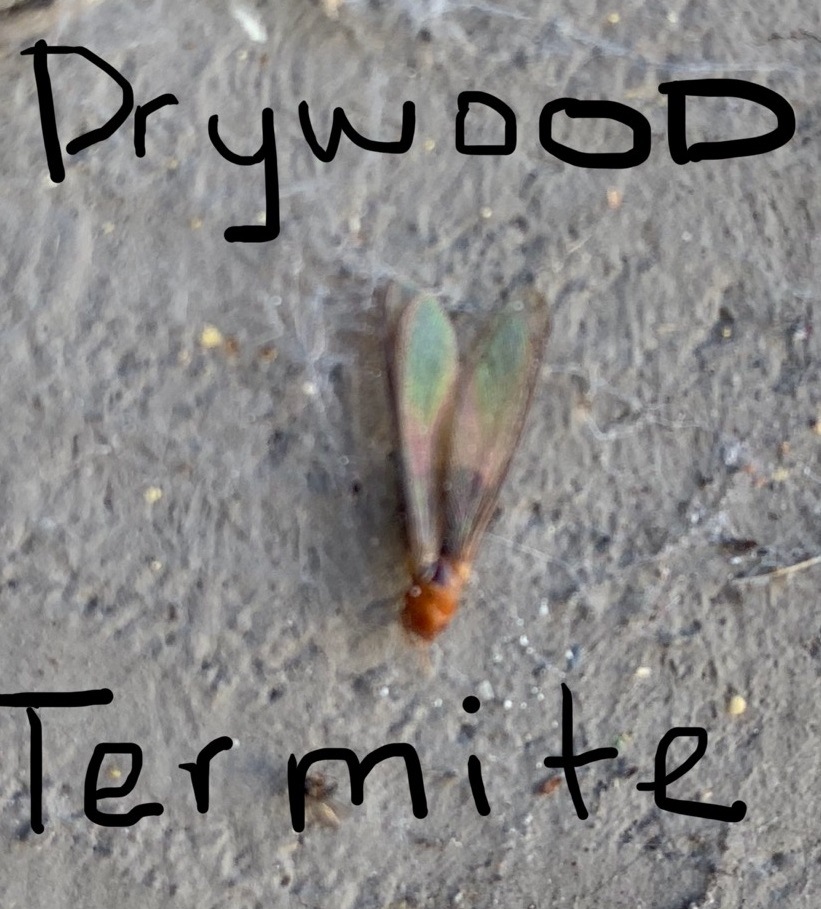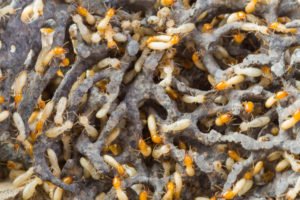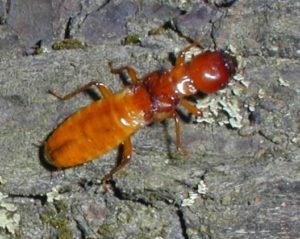
Drywood termites
Drywood termites or Kalotermitidae are termites that feed and nests on above ground wood. Unlike other termites, they don’t come into contact with wood through the soil and live on dry wood. However, they have the habit to dwell and feed on damp and rotten wood. Unlike other termite species, drywood termites lack true worker caste. What they have is pseudergates and nymphs, which serve as workers for the termite colony and can molt into soldiers or alates if necessary.
Members of Kalotermitidae live in small colonies – members would be from 50 – 3,000 depending on the age of the termite colony. They do not need water because they live off of the moisture produced when digesting cellulose; thus, producing fry and distinct fecal pellets. There are more than 400 species of drywood termites and are common to all continents except to Antartica. In the US, drywood termites often found in coastal states of the south and the southwest US. Prominent members of Kalotermitidae are West Indian drywood termite (Cryptotermes brevis) and Western drywood termite (Incisitermes minor).
Western drywood termite (Incisitermes minor)
- Soldiers are large and reddish-brown with visible teeth on the mandible
- Reproductive adult termite has an orange and brown head with a dark brown body.
- Soldiers are 8mm to 12mm in length.
- Reproductive adults are 11mm to 12.5mm in length.
- Pseudergates are slightly smaller.
- Western drywood termite swarmers appear during late summer and during sunny days.
- Termite colony members number to thousands.
West Indian drywood termite (Cryptotermes brevis)
-
- It is also known as Powderpost termite.
- Reproductive adult termite has a dark brown color.
- Pseudergates are pale and white.
- Soldiers have pale bodies and dark heads.
- Reproductive adult termite is 9mm to 11mm in length.
- Soldiers are 4mm to 5mm in length.
- West Indian drywood termite swarmers take flight from nights of April to June.
Termites are tiny soft-bodied insects known for their wanton destruction. Termites are often known as white ants; however, they are not related at all. Ants and termites are social insects but ants are from the order of Hymenoptera, whereas termites are from the order of Isoptera. Surprisingly, termites are kin to cockroaches. In fact, DNA analysis shows that termites are closely related to Wood roaches.
People Find the differences between Ants and Termites Confusing. It is important for you to know how to tell them apart. Ants and termites have different colors. Ants have shades of red, brown and black while termites are mostly pale and white in color but some species have shades of red, black or brown. Black ants have an obvious waist while termites do not have them. Lastly, ants have bent or elbowed antennae, while termites have straight and beaded ones.
There are thousands of termite species around the world but only a few of them are capable of significant damages to our homes and properties. The termite species that often cause damages are subterranean, dampwood and drywood termites.
Subterranean Termites
 Subterranean termites or Rhinotermitidae are termites that live in large colonies that contain hundreds and thousands of individuals. They are found all across North America and are highly invasive termites. In fact, they are the most common termite you would find in homes. A clear sign of subterranean termite infestation are blisters or dark areas in wooden walls or flooring. The damage will go unnoticed because termites would only consume spring wood and leave the grain and the exterior surface unscathed.
Subterranean termites or Rhinotermitidae are termites that live in large colonies that contain hundreds and thousands of individuals. They are found all across North America and are highly invasive termites. In fact, they are the most common termite you would find in homes. A clear sign of subterranean termite infestation are blisters or dark areas in wooden walls or flooring. The damage will go unnoticed because termites would only consume spring wood and leave the grain and the exterior surface unscathed.
Rhinotermitidae colonies are often in contact with soil. The members of this family are small. Soldiers and workers are 5mm on average and share a pale white color. The soldiers of this family sport a flat region behind their head which is called pronotum and produces stinging fluid as a defense. Average queen would produce at least 100 eggs each day. There are more than 300 members of this family and the most prominent ones are the Eastern Subterranean Termite (Reticulitermes flavipes) and Formosan Subterranean Termite (Coptotermes formosanus) or Formosan Termites.
Eastern Subterranean Termite (Reticulitermes flavipes)
-
-
- Soldiers and workers are pale to pale-tan.
- Soldiers have darker heads.
- Adult termite has darker colors.
- Soldiers and workers are 5mm to 7mm in length.
- Adult termite is 10mm in length.
- Swarming occurs during the mornings of February to April.
-
Formosan Subterranean Termite (Coptotermes formosanus)
-
-
- Workers are pale yellow or pale brown and lack prominent mandibles.
- Soldiers are pale yellow or pale tan with large oval-shape heads and prominent mandibles.
- Reproductive adults have a yellowish brown color and have hairy wings.
- Soldiers and workers’ size range from 6mm to 19mm in length.
- Reproductive adult termite is between 12mm to 17mm in length.
- Formosan termites are highly destructive and attack almost all sorts of structures.
- Swarming of Formosan termites is massive and occurs during dusk or calm and humid evenings from April to July.
-
Dampwood Termites
 Dampwood termites or the family Termopsidae are the largest termites with the average size of 25mm. There are only 20 species under this family and they are in Europe, Asia, Africa, Australia, and the Americas. They often nest in wet and rotting wood and require no direct soil contact. Termopsidae termite colony sizes are moderate in comparison to other termite species. These termites produce frass or fecal pellets, which indicates an infestation. A prominent member of Termopsidae is the Pacific Dampwood Termite (Zootermopis angusticollis).
Dampwood termites or the family Termopsidae are the largest termites with the average size of 25mm. There are only 20 species under this family and they are in Europe, Asia, Africa, Australia, and the Americas. They often nest in wet and rotting wood and require no direct soil contact. Termopsidae termite colony sizes are moderate in comparison to other termite species. These termites produce frass or fecal pellets, which indicates an infestation. A prominent member of Termopsidae is the Pacific Dampwood Termite (Zootermopis angusticollis).
Pacific Dampwood Termite (Zootermopis angusticollis)
-
-
- Pacific Dampwood termites are large termite species.
- Workers are 10mm to 15mm in length.
- Soldiers are 15mm to 20mm in length.
- Reproductive adult termite is 25mm in length.
- Worker termites have pale to milky white color.
- Soldiers are darker pale with a prominent dark brown head.
- Reproductive adult termite is orange to red in color.
- Swarming occurs throughout the year but is more prominent from August to October and happens during warm humid evenings just after sunset.
-
These termite species constantly threaten your home. Fortunately, there are things you can do to protect your home and investment. Start by setting up a free termite inspection now.
